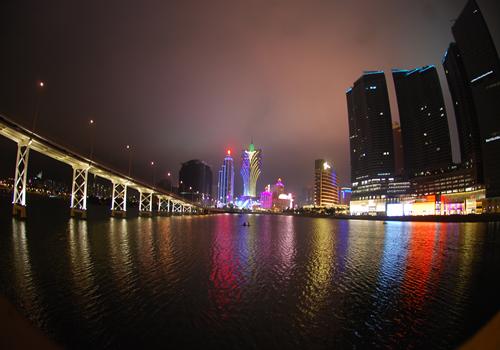|
Suzette, Serradura & Peri Peri

Photograph
by Preeti Verma Lal
"Oh! you from India . Get my sword out.” In curly white mop, rimless spectacles and Portuguese arms embroidered on a blue shirt, Antonio Neves Coelho looked a perfect portly grandpa but his guttural “sword” decree ricocheting down the wooden trusses and the gown of a painted woman had me stunned by the mahogany chair. In Antonio, the Michelin-recommended restaurant in Macau ’s Taipa island, I had walked in for the famed Crepe Suzette, not to be slain by a chubby chef. “Oh! From India . Calls for crepes and champagne,” Antonio proclaimed cleaning the antique sword with a white cloth. The dainty crepes lay on the table waiting to be drizzled with liqueur and then flamed, but the sword? Intrigued, I eyed the weapon, till the champagne arrived and the magic unfolded. Antonio tipped the bottle in his left hand, raised the sword and whoosh! in a blink the bottle was beheaded with the sharp sword and the frothing bubbly poured in elegant glasses. Antonio whooped in joy and emptied a bottle of rum on the simmering crepes. The metre-high flames metamorphosed the trite crepes into sinful Suzettes topped with orange rind, but in Macau I sure was not counting the calories.
No one does, actually. Not if you have to sink your teeth into the flaky buttery pastry cups and slurp the caramelized custard. Calling them ordinary egg tarts would be blasphemy, for these Portuguese egg tarts are the best in Asia . However, in Coloane island, tricky inflexions came much before I could catch the whiff of the tarts in Lord Stow’s Bakery. Don’t blame me, it is not easy to say Largo do Matduoro in one breath. For that’s the street where Englishman Anthony Stow first reinvented Pastie de Nata, the egg tart which traces its origin to the Lisbon waterfront area of Belem. To reach Stow’s, I followed the aroma and landed right in front of a non-descript building where women were busy flattening dough in moulds and men meticulously ladling the custard. All around there were tarts stashed on shelves. Ask how many tarts are baked each day and the confectioner would say a definite “many, many, cannot count”. Perhaps thousands. Perhaps more.
That day in Macau, sin was getting sweeter by the street. To catch a breath and count the calories, I sat by the salty sea across which stood China. The waves were thrashing against buff boulders and I was busy ticking dishes off the unending food list. In wait lay the African chicken, peri peri sauce, almond cookies that are Macau’s best souvenir, serrradura, the popular dessert, Portugal’ beloved bacalhau (codfish), risotto stuffed in pumpkin in City of Dreams’ Horizons where a gigantic sorrel Mao suit sculpture stands in a gurgling pool… The list was endless and the day not so long. But I could not ignore Fernando, a shack-like eatery which is known more for the signed currency notes that are symmetrically stuck within a brown frame than for its clams and chouricos (Portuguese sausage). On a 10 Indian rupee note, I noticed a Suvendu scribbled hastily, on another a Goswami written in slanted hand. I could only pick two out of the crowded collage, but there got to be more because nearly one lakh Indians visited Macau in the previous calendar year.
Let me confess, god sent me without a sweet tooth, but in the tiny island on which the Portuguese established a permanent settlement in 1557 by paying an annual rent of 500 taels of silver (one tael = 40 grams), not only was I defying the innate savory palate, but was even ready to redefine happiness in Rua da Felicidade (Road to Happiness). In the narrow lanes, happiness came in the avatar of almond cookies – round, scrumptious, not-so-expensive and oh!so Macanese. The almond in the cookie is either crumbled in the dough or coarsely shredded. Whatever the recipe, the almonds lend a nutty fragrance to the slim street. In the Road to Happiness, cookies are everywhere, so are dried meat fillets that resemble beef jerky. Don’t get scared if you find shop owners flaunting their scissors, that’s for you to sample the fillets – pork, beef is passé, try kangaroo, wild boar. Even ostrich!
The sun was prepping to go down the 338-metre tall Macau Tower and in Space Lisboa restaurant, the African chicken, a typical Macanese dish, was sizzling in a wok. There is nothing really African about the chicken, it is marinated in wine and olive oil and basted with coconut milk. Perhaps what is African is Portugal’s Moorish connection and the accompanying fiery peri peri sauce, a staple Angolan condiment.
That day in Macau, I would have dropped dead with another calorie, but I wanted to end the day on a high. Literally. At the 360 Café, a revolving restaurant on the 60 th floor of Macau Tower. Amidst cakes, jellies, marshmallow, jujubes and fudge, I picked serradura, a dessert made by whipping cream and condensed milk and topped with biscuit crumble. Ignore the bland ‘Sawdust Pudding’ translation, the Macanese believe that serradura could easily feature in Heaven’s dessert menu. I cannot vouch for that, what I know is that a friend so loves the serradura that he wants to christen his daughter Serradura.
Ever heard such a tribute to food before? Need I say anything more?
The Indian Express, 2010
|

